Related Research Articles

Clive Barker is an English writer, filmmaker and visual artist. He came to prominence in the mid-1980s with a series of short stories, the Books of Blood, which established him as a leading horror writer. He has since written many novels and other works. His fiction has been adapted into films, notably the Hellraiser series, the first installment of which he also wrote and directed, and the Candyman series.
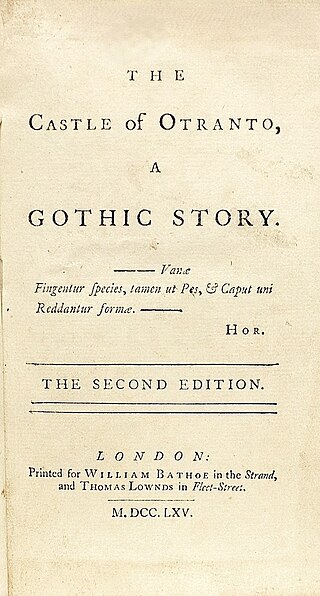
Gothic fiction, sometimes called Gothic horror, is a loose literary aesthetic of fear and haunting. The name refers to Gothic architecture of the European Middle Ages, which was characteristic of the settings of early Gothic novels.

Hellraiser is a 1987 British supernatural horror film written and directed by Clive Barker in his directorial debut, Based on Barker's 1986 novella The Hellbound Heart, the film’s plot concerns a mystical puzzle box that summons the Cenobites, a group of extra-dimensional, sadomasochistic beings who cannot differentiate between pain and pleasure. It stars Andrew Robinson, Clare Higgins, Ashley Laurence, and Doug Bradley as the leader of the Cenobites, identified in the sequels as "Pinhead".
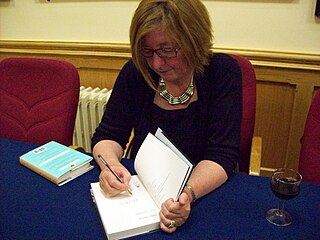
Patricia Mary W. Barker,, Hon FBA is an English writer and novelist. She has won many awards for her fiction, which centres on themes of memory, trauma, survival and recovery. Her work is described as direct, blunt and plainspoken. In 2012, The Observer named the Regeneration Trilogy as one of "The 10 best historical novels".
Robin Jarvis (born 8 May 1963) is a British young adult fiction (YA) and children's novelist, who writes dark fantasy, suspense and supernatural thrillers. His books for young adults have featured the inhabitants of a coastal town battling a monumental malevolence with the help of its last supernatural guardian (The Witching Legacy), a diminutive race of Werglers (shape shifters) pitched against the evil might of the faerie hordes (The Hagwood Trilogy), a sinister "world-switching" dystopian future, triggered by a sinister and hypnotic book (Dancing Jax), Norse Fates, Glastonbury crow-demons and a time travelling, wise-cracking teddy bear. (The Wyrd Museum series), dark powers, a forgotten race and ancient evils on the North Yorkshire coast (The Whitby Witches trilogy), epic medieval adventure (The Oaken Throne) and science-fiction dramatising the "nefarious intrigue" within an alternate Tudor realm, peopled by personalities of the time, automata servants and animals known as Mechanicals and ruled by Queen Elizabeth I. (Deathscent).

IDW Publishing is an American publisher of comic books, graphic novels, art books, and comic strip collections. It was founded in 1999 as the publishing division of Idea and Design Works, LLC (IDW) and is recognized as the fifth-largest comic book publisher in the United States, behind Marvel, DC, Dark Horse, and Image Comics, ahead of other comic book publishers such as Archie, Boom!, Dynamite, Valiant, and Oni Press. The company is known for its licensed comic book adaptations of films, television shows, video games, and cartoons.
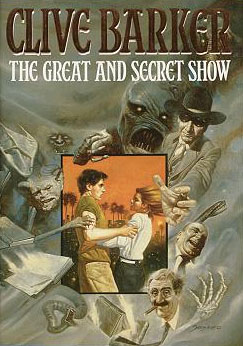
The Great and Secret Show is a fantasy novel by British author Clive Barker. It was released in 1989 and it is the first "Book of the Art" in a trilogy, known as "The Art Trilogy" by fans.

Everville is a 1994 fantasy novel by British author Clive Barker. The second in the Books of the Art series, it follows the 1989 novel The Great and Secret Show.
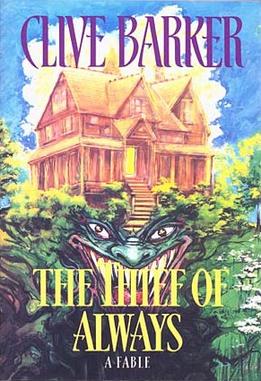
The Thief of Always is a 1992 novel written and illustrated by Clive Barker. The plot concerns an 10-year-old boy who journeys to a magical house, only to discover its master uses the home to attract children and steal their youth to ensure his own immortality.
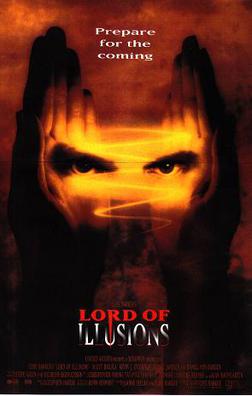
Lord of Illusions is a 1995 American neo-noir supernatural horror film written and directed by Clive Barker, based on his own short story The Last Illusion published in 1985 in the anthology Books of Blood Volume 6. The same story introduced Barker's occult detective Harry D'Amour, who later appeared in several prose stories and comic books. Lord of Illusions is D'Amour's first onscreen appearance, with the character portrayed by actor Scott Bakula. Other actors appearing in the film include Kevin J. O'Connor, Famke Janssen and Daniel von Bargen. The story features D'Amour, who has had several experiences with the supernatural, embarking on an investigation involving a stage illusionist named Swann and a cult led by a sorcerer named Nix.

Harry D'Amour is a fictional occult detective created by author, filmmaker, and artist Clive Barker. He originally appeared in the short story The Last Illusion in Books of Blood Volume 6, an anthology written by Barker and published in 1985. D'Amour has appeared in other Clive Barker prose stories, as well as comic books published by Boom! Studios, and the 1995 film Lord of Illusions wherein the character is portrayed by actor Scott Bakula. Following this, the comic book adaptation of Barker's novel The Great and Secret Show depicts D'Amour as resembling Bakula. In 2012, the cover for Hellraiser #18 used actor Thomas Jane as the model for D'Amour. In multiple stories, D'Amour is depicted as living in the same reality as Barker's popular creations the Cenobites and the Hell Priest.

In scholastic philosophy, "quiddity" was another term for the essence of an object, literally its "whatness" or "what it is".
Jeff Mariotte is an American author who lives in Arizona. As well as his own original work, he is best known for writing novels and comic books based on licensed properties.
Mel Odom is an American writer known primarily for science fiction and fantasy novels set in existing properties.

Steve Niles is an American comic book author and novelist, known for works such as 30 Days of Night, Criminal Macabre: A Cal McDonald Mystery, Simon Dark, Mystery Society, Batman: Gotham County Line, Kick-Ass – The New Girl, and Kick-Ass vs. Hit-Girl.
Hellraiser is a British-American horror media franchise that consists of eleven films, as well as various comic books, and additional merchandise and media. Based on the novella The Hellbound Heart by English author Clive Barker, the franchise centers around the Cenobites which includes the primary antagonist named Pinhead.
Nick Percival is a British graphic artist and graphic novelist primarily known for his published comic book, concept artwork and career in computer animation directing.
Sam Shearon, also known under the pseudonym and credited / published also as Mister Sam Shearon is a British dark artist born in Liverpool, England. Specialising in horror and science-fiction, his work often includes elements inspired by vintage tales of monsters and madmen, dark futures, post apocalyptic genres including cyberpunk and industrial wastelands and classic literature including H.P.Lovecraft's The Call of Cthulhu, Oscar Wilde's The Picture of Dorian Gray and the modern classics Clive Barker's Hellraiser and the Books of Blood all of which he has fully illustrated.

Christopher Ryall is best known as the former President, Publisher, and Chief Creative Officer of IDW Publishing, and as a writer in the comic book industry. In February 2011, his Eisner Award-nominated series, Zombies vs. Robots, co-created with artist Ashley Wood, was optioned by Sony Pictures for Michael Bay’s Platinum Dunes with Mike Flanagan as director.

Daryl Gregory is an American science fiction, fantasy and comic book author. Gregory is a 1988 alumnus of the Michigan State University Clarion science fiction workshop, and won the 2009 Crawford Award for his novel Pandemonium.
References
- ↑ Joshi, S.T. (2001). The Modern Weird Tale. McFarland. p. 128. ISBN 9780786409860 . Retrieved 9 May 2015.
- ↑ "Current Book Projects". Clive Barker. Retrieved 9 May 2015.
- 1 2 Joshi, S. T. (2006). Icons of Horror and the Supernatural, V2. Greenwood. p. 587. ISBN 9780313337826 . Retrieved 9 May 2015.
- 1 2 Savory, Brett. "The Clive Barker Interview". The Internet Review of Science Fiction. Archived from the original on 6 November 2012. Retrieved 9 May 2015.
- ↑ Hamilton, Geoff; Jones, Brian (2009). Encyclopedia of American Popular Fiction. Facts on File. p. 21. ISBN 9781438116945 . Retrieved 9 May 2015.
- ↑ Winter, Douglas E. (2002). Clive Barker: the dark fantastic. Harper Collins. pp. 316, 383. ISBN 000715092X . Retrieved 9 May 2015.
- ↑ "BREAKING: Clive "figured it out" regarding ending of Art Trilogy". Clive Barker Podcast. 29 August 2014. Retrieved 14 May 2015.
- ↑ "FAQ". Clive Barker. Retrieved 14 May 2015.
- ↑ "Everville (review)". Booklist. Retrieved 9 May 2015.
- ↑ Budrys, Algis (4 February 1990). "In summary, this wasn't a bad idea". Chicago Sun-Times (subscription required). Archived from the original on 24 September 2015. Retrieved 9 May 2015.
- ↑ Mabe, Chauncey. "Barker's 'Everville' Is Nowhereville". Sun-Sentinel. Archived from the original on 3 March 2016. Retrieved 9 May 2015.
- ↑ Tucker, Ken. "ONE UNIVERSE AT A TIME PLEASE". New York Times. Retrieved 9 May 2015.
- ↑ Foster Wallace, David (19 February 1990). "The Horror of Pretentiousness". Washington Post (subscription required). Archived from the original on 7 March 2016. Retrieved 9 May 2015.
- ↑ "The Great and Secret Show: The First Book of the Art (review)". Publishers Weekly. Retrieved 9 May 2015.
- ↑ "Everville: The Second Book of the Art (review)". Publishers Weekly. Retrieved 9 May 2015.
- ↑ "AICN COMICS REVIEWS BATMAN! ULTIMATES! CLIVE BARKER'S THE GREAT AND SECRET SHOW! AND MUCH MORE!!!". AICN. Retrieved 12 May 2015.
- ↑ "IDW RELEASES CLIVE BARKER'S "THE GREAT AND SECRET SHOW" IN DECEMBER". IDW/CBR. Retrieved 12 May 2015.
- ↑ Royer, Dan. "Comic Review: The Complete Clive Barker's Great And Secret Show". HorrorNews.net. Retrieved 12 May 2015.